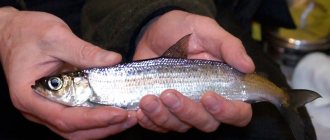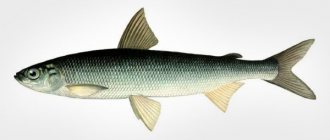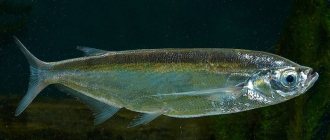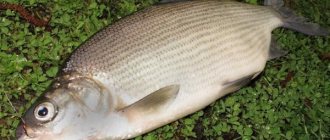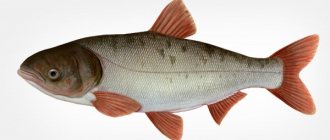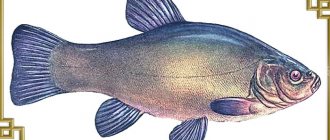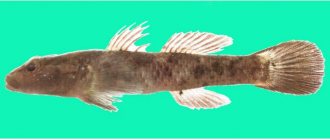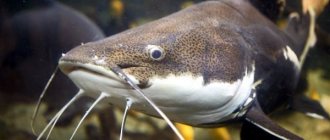- Wild animals
- >>
- Fish
The gudgeon is distributed throughout almost all of Europe and the Asian part of Russia: these small fish can be found in large quantities in almost any river. They live near the bottom and feed on various small animals. They are found in schools, so you can catch a lot at once in a short time, but fishermen prefer other prey, and they are more often used as bait.
Origin of the species and description
Photo: Peskar
Fish are very ancient creatures, they appeared over 520 million years ago. The first of them looked more like worms than fish, but then, 420 million years ago, the ray-finned class arose - the principle of the structure of their fins was the same as that of modern fish.
This is not surprising, since the vast majority of fish inhabiting the planet today, including minnows, belong specifically to the ray-finned species. But over the past hundreds of millions of years, they have traveled a long evolutionary path; first, those species that inhabited our planet in the Paleozoic era, and then the representatives of the Mesozoic fauna that replaced them, became extinct.
Video: Minnow
Most modern species, with the exception of rare “living fossils,” arose already in the Cenozoic era, and this fully applies to fish. It was they who began to dominate the water at this time, and primarily the clade of bony fish - dominance passed to them from sharks.
Only then did the first cyprinids appear - and it is to this family that minnows belong. This happened about 30 million years ago. It is not known for certain when the gudgeons themselves arose; there are finds dating back 1 million years, but it is possible that this happened noticeably earlier.
The genus was described as J-L. de Cuvier in 1816, received the name Gobio. It includes many species and new ones continue to be described. For example, only in 2015 a scientific description of the species tchangi was made, and a year later artvinicus.
Catching and value
The fish has no industrial value and is caught primarily for personal consumption. Also used as bait for catching predators. The most suitable tackle is a fishing rod or donka. Takes from late April to November (depending on the region and weather). It is better to catch from sunrise to lunch, while there is no heat.
It takes on various worms, most readily on bloodworms. For fishing, light fishing rods with thin fishing line and small hooks No. 4-8 are used. To attract schools of fish, the water is stirred up - the gudgeon (like the spined lance) goes for it, forgetting about the instinct of self-preservation. This was noticed by many swimmers in rivers.
Appearance and features
Photo: What a minnow looks like
The length of an adult gudgeon reaches 10-15 cm, but can grow to larger sizes - 20-22 cm. Its body near the abdomen is slightly flattened. A very characteristic feature is antennae, one on each side. The mouth of this fish is located at the bottom - this makes it more convenient for it to eat living creatures or plants, swimming above the very bottom.
There are two rows of teeth in the mouth, their tips are slightly curved. The head is flattened, the snout of the fish is long, its upper jaw protrudes above the lower jaw. The upper part of the body is brown with a greenish tint, the sides are silvery. The fish is covered with dark spots, sometimes so many of them that they merge into stripes.
This coloring allows it to remain unnoticeable when it swims near the bottom: from above, the fish may appear to be part of the mud or a lump of algae. In the water, the gudgeon can be distinguished by its pectoral fins: they are large relative to the body and widely spaced, as a result of which, when it swims, it looks almost triangular.
Its dorsal and anal fins are short, without serrated rays. The fins are light gray, with a slight brown tint, except for the tail and dorsal - they are brown, but as if faded. As they grow older, minnows gradually darken more and more.
Interesting fact: Minnows can communicate with each other using squeaks and squeaks - this is a rather rare skill for fish, although not unique.
Spawning
Lake minnows prefer to spawn in small rivers and streams, which flow into the main body of water in large numbers. The spawning grounds of the gudgeon are shallow areas with a sandy or rocky bottom; there are also cases where, due to a lack of spawning areas, the gudgeon laid eggs on concrete slabs of dams and bridges. The female's productivity is low. On average, a female gudgeon lays from one to three thousand eggs. The gudgeon grows very slowly, and it is very rare to find an individual longer than 15 centimeters. The gudgeon also has a lot of enemies in the form of predators that willingly eat up the gudgeon populations in the reservoir.
Where does the gudgeon live?
Photo: Minnow in the river
Distributed in the northern part of Europe: it can be found in almost every river flowing into the seas of the Arctic Ocean. What all these rivers have in common is that their waters are relatively cold—that’s exactly what minnows like. That is why they are found less frequently in the warm rivers of southern Europe that carry water to the Mediterranean Sea - they are more favorable for other fish.
However, they also live in some of the rivers of the Mediterranean basin, for example, in the Rhone. They also inhabit the rivers of the Black Sea basin: Danube, Dnieper, Dniester. They live in most of the Russian rivers west of the Ural Mountains, such as the Volga, Don and Ural.
They live in the waters of Scandinavia. They were introduced into Scotland, Ireland and Italy, multiplied and have now become common inhabitants of water bodies there. In the Asian part of Russia they are found all the way to Primorye, and are also found in the reservoirs of Central Asia.
Apart from water temperature, the principles by which gudgeons disperse have not been reliably established: these fish can be found in large calm rivers and stormy mountain rivers, and even in streams; they are found in large lakes and very small ponds. It is only known that the cleaner and more oxygenated the water, the higher the likelihood of encountering them.
They also love ponds with a bottom made of crushed stone or sand. They live near the bottom in shallow water, and most often remain in the same place where they were born, if it is convenient enough and capable of feeding. Even if they have to migrate (usually the whole flock does this at once), they usually do not move long distances, but only a kilometer or a few.
Every autumn they go to deeper places, looking for where there is more silt, so that it will be warmer when the river is covered with ice. When a body of water begins to freeze, you can often see groups of minnows gathering near the springs, from which water continues to flow. Until the last minute, they try to find unfrozen areas with oxygen-saturated water.
In winter, they try to find a place where the water is warmer: they go into lakes or ponds, they can swim into underground waters or look for hot springs. More often they simply lie down in holes at the bottom and burrow under the silt. If gudgeons are placed in a lake with clean water, then they breed in it in a matter of years, but at the same time they do not reach the size of river ones.
Habitat of gudgeon fish
The gudgeon has taken a fancy to a significant part of Europe. It swims in the tributaries of the Yenisei and Amur. It can also be found in Southern Siberia and Transbaikalia.
- This fish loves large and small rivers with shallow depths. It can also live in ponds and lakes.
- In rivers it likes to gather in larger schools; in stagnant bodies of water several large fish gather.
- It mainly swims in coastal areas, where it feeds on invertebrates.
- He feels fine in still water, but prefers to swim in the current.
- Basically, the gudgeon swims near the bottom, hiding behind shelters, where it is easiest to catch passing living creatures.
The peculiarity of the gudgeon is that it likes to follow the river current, so it is rarely seen in a standing position.
When the gudgeon reaches puberty, it reaches 8 cm in length. Females are larger than males. The fish lays eggs between April and June. For spawning, the gudgeon chooses a sandy and rocky bottom surface. The eggs are laid in small portions.
What does a gudgeon eat?
Photo: Common gudgeon
The gudgeon's diet includes:
- mayflies;
- insects;
- worms;
- shellfish;
- caviar;
- fry.
As you can see, this fish is a predator and prefers to feed on various small animals. Gudgeons can also eat plant food, but in rather small quantities, and they mainly obtain food for themselves by hunting, which they can conduct from morning to evening. They mostly spend this time examining the bottom, diligently looking for prey, sometimes they start digging, feeling everything with the help of sensitive antennae, from which nothing can hide.
Sometimes minnows can even set up an ambush in a place where the current is quite fast and carries a lot of prey. They hide next to the current, near some stone, wait until a small fish or some kind of mollusk swims by, and after waiting, they deftly snatch it.
In spring and early summer, when other fish go to spawn, minnows switch to feeding on eggs and fry, purposefully search for them and often swim in these searches from the bottom, sometimes to the very surface. Minnows are attracted to movement, and therefore, in order to lure them, they usually stir up the water.
Interesting fact: Although people rarely use gudgeons themselves as food, they are useful: their meat contains a lot of vitamins and microelements, and frequent consumption has a good effect on the condition of the cardiovascular system, bones and skin. They also contain a lot of iodine, which helps with thyroid problems. At the same time, the fat content of gudgeon meat is minimal, so it can be consumed during a diet or when recovering from an illness.
Lures for minnows
When fishing for gudgeon, baits of animal origin are mainly used. In most cases, fishermen do not wonder what to catch minnows with and catch them with ordinary earthworms.
- To catch gudgeons swimming in lakes and ponds, bloodworms can be used as bait.
- An excellent option would be to use a butterfly with clipped wings and a caddis fly.
- Of the plant baits, fish respond best to wheat grains.
Often they use pearl barley, dough or pieces of bread. The fish does not respond to a large bait that exceeds the size of the gudgeon’s mouth.
Features of character and lifestyle
Photo: Minnow fish
Minnows are usually active during daylight hours; they are constantly looking for prey, mainly at the bottom, but in shallow water. The best chance of catching them is close to a rocky or sandy shore. At night, minnows rest, clinging to the bottom with their fins so that the current cannot carry them away during inactivity.
Usually, even before sunset, they hide among the plants near the rifts, so it’s convenient to catch them at this time if you know such places. But this does not always happen: if predators have settled near the minnows, hunting them and also active during the day, they try to hide and go out in search of food later, at dusk.
They see poorly in the dark, so in such cases they don’t have much time left, and the second period of activity occurs in the dawn hours. Such a change in the daily routine really helps to confuse predators, but it is only useful when there are no or few predatory fish in the reservoir that are active at dusk.
Minnows can swim quite quickly, including against a strong current, but usually do not show the energy expected from such a small fish: they like to rest and usually swim lazily, so they can be caught with a net.
Interesting fact: During the hottest days of summer, minnows become lethargic and vulnerable. At the peak of the heat just after noon, they rest for a long time near some stone, remaining motionless, for which they were nicknamed columnars.
Gudgeon river or sea fish
The gudgeon is a universal fish that lives in both salt water and fresh water.
The sea gudgeon is common in Europe, in the northeast. It can be found in the basin of such seas as: Northern, Baltic, White.
Freshwater gudgeon lives in rivers, mainly in sandy and rocky areas. They can live in reservoirs or ponds. They don't like fast currents. They prefer to stay in large groups. Particularly sensitive to the oxygen content in water.
Social structure and reproduction
Photo: Peskar in Russia
On average, by the age of 3, minnows are ready to breed. At the same time, as at an earlier age, they continue to remain in the group. In such schools of minnows, fish of all ages coexist; joining together increases their chances of survival when attacked by a predator.
This makes it more likely that one of them will notice the attack earlier, and the predators will not be able to attack everyone at once, even if there are several of them, which means that most of the flock will be able to escape. But what the minnows don’t know is that some large predators are attracted precisely by their schooling lifestyle: it makes little sense for a large fish to hunt for one minnow, otherwise you can catch several at a time.
They spawn once a year, spawning begins after the water warms to 7-8 °C. In warmer latitudes this can happen in April, and in the north only in June. Spawning does not take place at once, but in portions and can last up to two months. One female can lay from 8 to 13 thousand eggs. She does this near the place where she lives, also in shallow water. Due to the fact that minnows splash noisily while laying eggs, they attract the attention of predators who begin to devour both the eggs and the minnows themselves, which is why this is the most dangerous time of the year for them.
The eggs are small and bluish. They have an adhesive shell, and therefore quickly stick to snags, stones or plants at the bottom, they are covered with sand or silt, after which it becomes difficult for other fish to find them to eat. Therefore, the most dangerous time for them is immediately after postponement. Immediately after emergence, the larvae have disproportionately large pectoral fins and prominent eyes. For 3-4 days they just lie on the bottom, they have no reaction to light at this time. After this period ends, they begin to actively feed on detritus and benthos: various small invertebrates living near the bottom.
At first they grow very quickly and, if there is enough food around, they reach a length of 6 cm in just three months. Then growth slows down and the gudgeon grows to a size of 12-14 cm by 3-4 years, then it is already considered fully grown and, although continues to grow, but very slowly. Life expectancy can reach 8-10 years, but since there are too many people willing to profit from minnows, few of them live to old age, most of them die at no more than 4-6 years. Minnows caught in the wild can live in an aquarium, but their life expectancy in such conditions is reduced - even young fish are unlikely to live more than 3 years.
Anton Chubukov's blog
The gudgeon is a well-known fish, a ubiquitous fish and a household name. “Again, did you bring the minnows alone? Give it to the cat...” The wise gudgeon was glorified by Saltykov-Shchedrin. The gudgeon is a wonderful live bait. Many children tried to keep minnows in an aquarium. Usually, these experiments do not last long - some forget to change the water on time, others get bored, others forget to lock up the cat, and others switch to breeding tropical fish and evict nondescript natives. But in vain - in good lighting in a spacious vessel, the gudgeon is beautiful and very funny. The common gudgeon inhabits large rivers and small rivulets, and is less common in flowing ponds and lakes. Usually, throughout the spring and summer, schools of minnows stay on the rifts or close to them, in shallow places with a rocky or sandy bottom, which is why they got their name. Minnows are diurnal and never swim at night, but lie motionless on the bottom, resting their lower fins on it - as if on supports. In the midday heat, they sometimes also stand in one place for a long time, for which gudgeons in some places are called “columns” or “columns”. The gudgeon feeds on small bottom-dwelling invertebrates and always stays close to the bottom, the color of which camouflages it well with its variegated coloring. In spring, it eats large quantities of eggs of other fish. They grow very quickly, especially in rivers. In October or November, gudgeons almost disappear and go to winter in ponds or lakes or deep river holes, perhaps sometimes burying themselves in silt. Our large minnow, nicknamed “Arsenic” (the children named the inhabitants of the aquarium after chemical elements), was saved from the fate of a fishing bait in October. His brother was wounded in a crowd of live bait and died of suppuration. A smaller gudgeon from the same “Ptichka” was first sucked into the sterlet, and then gobies chewed it up. (Gobies generally catch any small thing on the bottom - they only escape from them in the upper layers of the water). All day long, Arsenic swallows and spits out sand, hoping to get something edible. The fish enthusiastically consumes sturgeon feed and frozen bloodworms. Naturalists note that the gudgeon is a cold-water fish and is accustomed to the current. It is recommended to keep it at a temperature no higher than 22 degrees. In my aquarium, this condition is met thanks to a fan system and powerful aeration. You can get minnows with a net, but it’s easier to buy them from live bait dealers. In winter, minnows are on sale more often than in summer. The common gudgeon is the most common, but not the only type of gudgeon in Russia. There is a great variety of minnows in the Far East, and in the Middle Zone, the Red Book white-finned minnow (Romanogobio albipinnatus) is sometimes found. Tags: aquarium, minnow
Natural enemies of minnows
Photo: What a minnow looks like
Many predatory fish hunt for minnows, which is why they need a coloring that allows them to be inconspicuous near the bottom.
Most often he becomes prey:
- burbot;
- asp;
- carp;
- pike;
- otters;
- kingfisher;
- cancer.
Burbots and asps are especially fond of minnows - they try to settle close to places where they live in abundance, and minnows often predominate in their menu. To a lesser extent this applies to pike. But the more dangerous enemies for minnows are carps, even though they eat a wide variety of foods and do not specifically excrete minnows.
The point is their abundance: carp in some reservoirs multiply so much that they crowd out other predators, and of course, when there are so many of them, it is very difficult for gudgeons to escape from them. If even one gudgeon is enough for smaller fish, large predators often burst into their school and try to stun several at once with the help of tail blows, and only after that they start eating.
Since minnows spend most of their time at the bottom, it is predatory fish that are the primary threat to them. But, since they swim in shallow water, they can also be caught by waterfowl mammals and birds, which are especially dangerous during spawning.
Another dangerous animal is cancer. They usually do not catch adult fish, because they are too slow for this, but they very often come across larvae that have poor vision. Finally, minnow eggs are often eaten by a wide variety of fish and other aquatic animals - there are so many of them that only a small part of the eggs escapes this fate and survives at least to the larval stage.
Minnow fishing
Fishing for gudgeon is carried out throughout the year. It is caught using the same methods as any other small fish that lives in lakes and rivers.
In clear weather, the gudgeon can be found jumping out of the water, and thus its location can be determined. Jumping out helps the gudgeon escape from predatory underwater inhabitants. During the day he is hunted by pike and asp, in the evening he needs to beware of perch and pike perch.
The bite does not depend on the time of day - at different times of the day, fish can be caught in different ways. During hot hours, he hides behind plants and other shelters.
The easiest way to catch this fish, which children resort to, is to use a jar of bread cats, tied with a gauze bandage. Experienced fishermen use bottom and float gear.
Float tackle
You don't need expensive fishing gear to catch minnows in winter and summer. All you need is a simple rod, line, float, hooks and sinkers. There is no point in choosing a hook larger than #16. The diameter of the fishing line should be chosen equal to 0.08-0.10 mm. If the bite is not going well, you should use a thinner line.
- The gudgeon will be caught more successfully if you bring the bait directly to the fish.
- To do this, you need to lower it to the bottom level.
- The minnows themselves are not inclined to swim specifically for bait, trying not to rise far from the bottom surface.
To speed up the fishing process, the coastal water can be stirred up with your hands or feet, thereby quickly luring a school of minnows.
Bottom gear
After the spring melting of the ice edges on reservoirs, gudgeon and ruffe are the first to become available to anglers. When catching gudgeon, a donka, a half-bottom, and a standard bait are used. At the half-bottom, the float is moved to the top of the rod. Sometimes this feature allows you to make the sinker more heavy. The bait is often carried away by the current, but near the coastal zone this disadvantage does not interfere with catching minnows.
Leashes
Leashes must be used when fishing. The length of the leash should be no more than 10 cm. When using a long leash, you can miss a significant part of the bites. The diameter of the leader should be 0.01 mm less than the diameter of the fishing line. This avoids further tangling of the leash.
So that even in a strong current you can easily lower the bait to the bottom, you should use only one small sinker, attaching it at the junction of the leash and fishing line. Ideally, the sinker should easily hold the equipment, but when biting, allow it to move freely with the flow of the reservoir.
- To catch minnows, you should choose a ball-shaped float with a low load capacity of 1 g.
- If the fish is caught at a depth of about 1 meter, the carrying capacity of the float can reach 0.2-0.4 g.
These swimming trunks are made of wood. Most of all, minnows love stationary bait, slightly oscillating in the current. A stable float, despite the existing inertia, allows you to achieve this effect.
Gudgeon in cooking
Minnow meat is white, soft, slightly sweet, rich in protein, amino acids, contains polyunsaturated fatty acids, vitamins A, D, phosphorus, iodine, fluorine, calcium. The gudgeon is a small but useful fish. It makes excellent fish soup, but the most delicious gudgeon is fried. The gudgeon is fried in flour, breadcrumbs, and onions. Fry in a frying pan or grill. The French prefer fried minnows in sour cream or tomato sauce with lemons. They also make kebabs. The only inconvenience of cooking them is their small size and a lot of scales.
